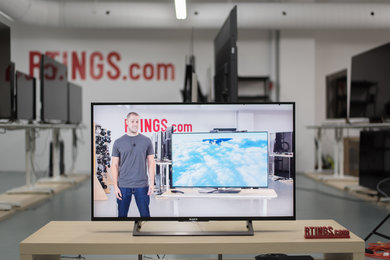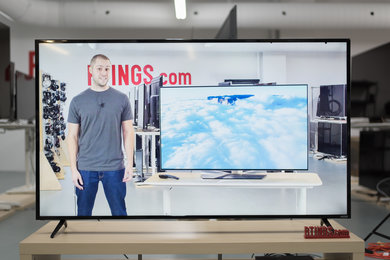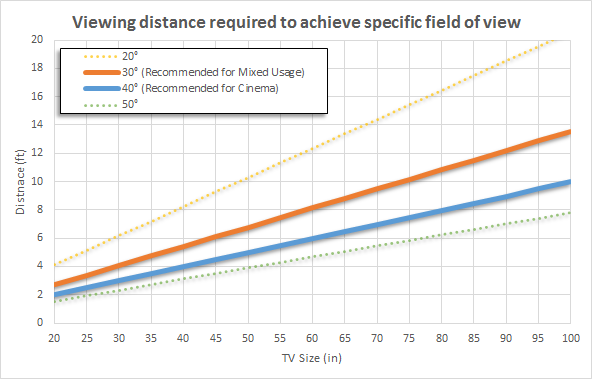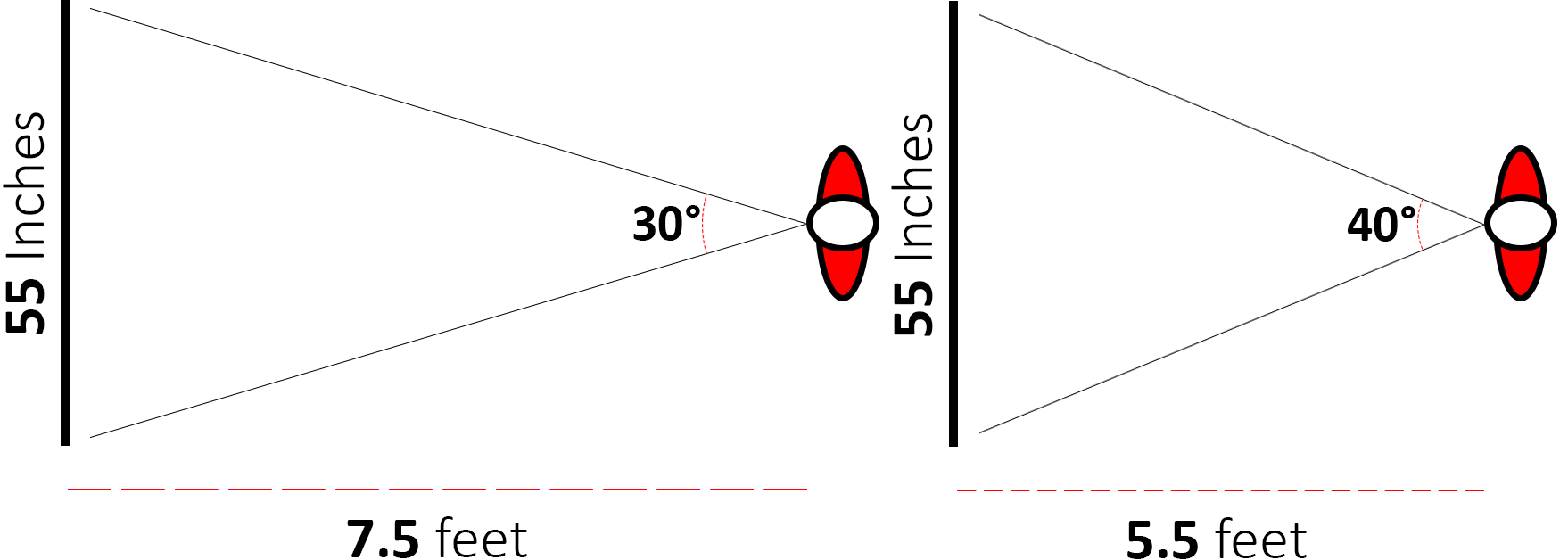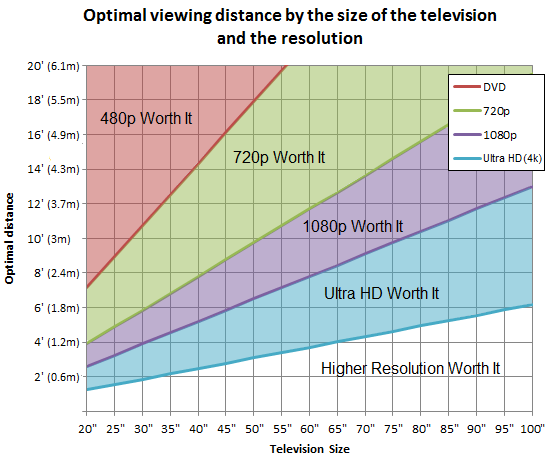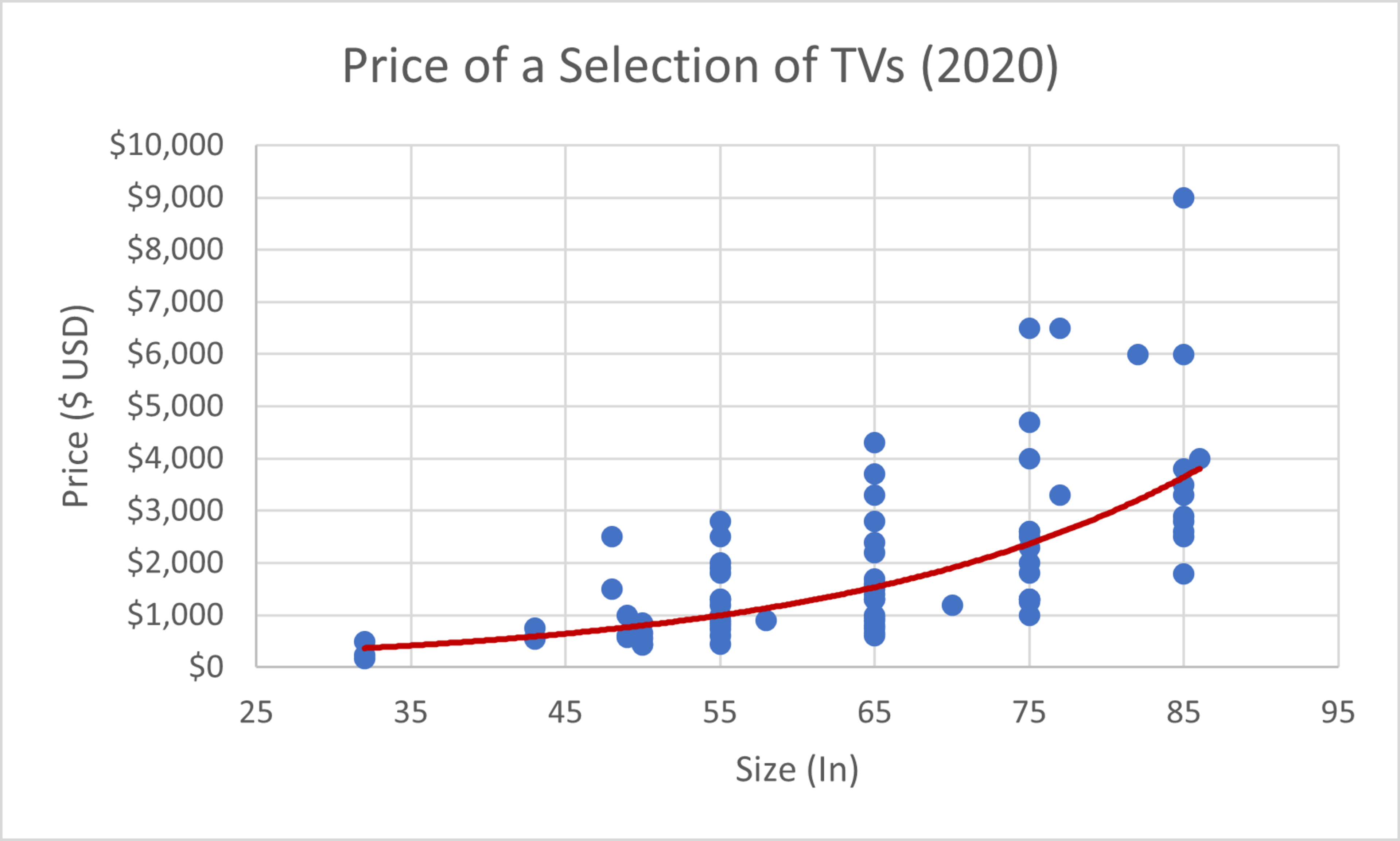- Table of Contents
- Intro
- The science behind our TV size and distance calculator
- Conclusion
- Comments
TV Size to Distance Calculator and Science
Bigger and closer is usually better when it comes to choosing the perfect television for your room. Size not only affects the price of a television, but it also has a huge impact on the perceived picture quality. Use our size to distance calculator to see which size TV you should get based on how far away you'll be sitting from the screen.
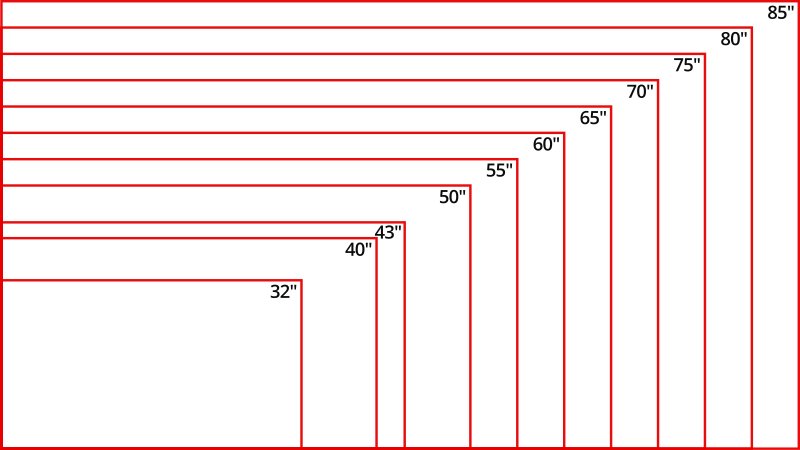
| Size | Width | Height | Area |
|---|---|---|---|
| 32" | 27.9" 70.9 cm |
15.7" 39.9 cm |
438 in² 0.283 m² |
| 40" | 34.9" 88.6 cm |
19.6" 49.8 cm |
684 in² 0.441 m² |
| 43" | 37.5" 95.3 cm |
21.1" 53.6 cm |
791 in² 0.511 m² |
| 50" | 43.6" 110.7 cm |
24.5" 62.2 cm |
1068 in² 0.689 m² |
| 55" | 47.9" 121.7 cm |
27.0" 68.6 cm |
1293 in² 0.835 m² |
| 60" | 52.3" 132.8 cm |
29.4" 74.7 cm |
1538 in² 0.992 m² |
| 65" | 56.7" 144.0 cm |
31.9" 81.0 cm |
1809 in² 1.166 m² |
| 70" | 61.0" 154.9 cm |
34.3" 87.1 cm |
2092 in² 1.349 m² |
| 75" | 65.4" 166.1 cm |
36.8" 93.5 cm |
2407 in² 1.553 m² |
| 80" | 69.7" 177.0 cm |
39.2" 99.6 cm |
2732 in² 1.763 m² |
| 85" | 74.1" 188.2 cm |
41.7" 105.9 cm |
3090 in² 1.993 m² |
Loading...
Loading...
The science behind our TV size and distance calculator
A lot goes into determining the best viewing distance, and there are several different criteria you can use. Aside from size, things like resolution and even how strong your eyesight is can affect how you see the screen. Because everyone's eyesight is different, this is less an exact science and more of a general guide based on scientific principles of vision and resolution.
Field of View
Since resolutions found today are almost exclusively 4k (Ultra HD), it takes a very big TV watched from very close to see imperfections related to the resolution. Because of this, you can sit closer to your TV than you would with lower resolutions and have a more immersive experience. Think of it like a movie theater: the more a TV fills your view, the more immersive it will feel.
That doesn't mean you should be sitting a foot away from your TV. Having the largest screen possible isn't always ideal. The human visual system has a total horizontal field of view of about 200 degrees, although a portion of that is peripheral vision. While it makes some sense to get as large a TV as you can for movies, not all content is made to fill the entire field of view. This becomes very apparent if you try to watch sports from up close while fixating on a single part of the screen, which quickly starts to feel nauseating.
The Society of Motion Picture and Television Engineers recommends sitting at a distance where the screen fills up a minimum of 30° of your field of vision for a good experience.
This is generally good guidance, but people who use their TVs mostly for watching movies might benefit from sitting a bit closer to get a more theater-like experience. The SMPTE "reference" position for movie theaters and the THX recommendation is about 40°. The minimum angle of vision works well for most usages, though, and sitting at a distance where the screen fills 30° of your horizontal field of view should be comfortable for most people.
It's also worth noting that this angle assumes a single person is viewing the TV head-on at eye level. Not all living room setups meet these conditions exactly, so it's best to use this as a guideline only. Learn more about viewing angles.
| Screen Size | Recommended Mixed Usage Distance (30°) |
Recommended Cinema Distance (40°) |
| 25" | 3.4' (1.04 m) | 2.5' (0.77 m) |
| 30" | 4.1' (1.24 m) | 3' (0.92 m) |
| 35" | 4.8' (1.45 m) | 3.5' (1.07 m) |
| 40" | 5.5' (1.66 m) | 4' (1.22 m) |
| 45" | 6.1' (1.86 m) | 4.5' (1.37 m) |
| 50" | 6.8' (2.06 m) | 5' (1.53 m) |
| 55" | 7.5' (2.28 m) | 5.5' (1.68 m) |
| 60" | 8.2' (2.48 m) | 6' (1.83 m) |
| 65" | 8.9' (2.69 m) | 6.5' (1.98 m) |
| 70" | 9.5' (2.9 m) | 7' (2.13 m) |
| 75" | 10.2' (3.1 m) | 7.5' (2.29 m) |
| 80" | 10.9' (3.31 m) | 8' (2.44 m) |
| 85" | 11.6' (3.52 m) | 8.5' (2.59 m) |
Angular resolution
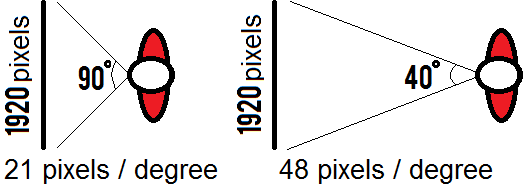
Angular resolution is the point at which the eye can 'resolve' or distinguish individual details in an image. Experts suggest that someone with 20/20 vision (or 6/6 using the metric system) can distinguish details that are 1/60th of a degree apart. Our ability to resolve details is determined not only by visual acuity but also by distance. At a certain distance, depending on your eyesight, your eyes won't be able to distinguish every detail. So, if you sit too far, your eyes won't be able to resolve the image, but if you sit too close, that image will appear pixelated. For lower resolutions, you have to sit a bit further than preferable to not notice the pixels, while 4k resolutions and higher give you more freedom.
For instance, sitting close to a 1080p TV can look almost like watching through a screen door because you can see the individual pixels, even if it's playing a high-quality 1080p HD movie. Increasing your distance to the TV also increases the density of details, producing a better image. Since 4k TVs have such a large density of pixels, it's much more difficult for this issue to arise. You need to be quite close to a fairly large TV for the pixels to be noticeably distracting.
With 8k TVs, that density increases further, making it even harder to notice flaws with the resolution unless you're sitting extremely close. However, this also decreases the point at which the perceived difference in picture quality becomes noticeable. Because the pixels are more densely packed with an 8k resolution, you need to sit closer to actually resolve those details. For that reason—content aside—8k only really makes sense if you want a really big screen and plan on sitting close to it. Learn more about the difference between 4k and 8k.
All that said, everyone's eyesight is a little different, and most TVs now are at least capable of 4k, so visual acuity isn't really the best way to find the right distance. It should instead be used to figure out the closest you can sit to a TV without hitting its resolution limitation.
How do you interpret the chart?
This chart shows the point at which an upgrade in resolution becomes worth it depending on size and distance to the TV. Each line represents the optimal viewing distance for each resolution, but any TV that falls within the range of that color will be suitable to notice a difference in picture quality. So, for example, if you have a 65 inch TV, the viewing distance at which the eye can actually process the details of 4k content is about 4 feet. However, any distance between 4 and about 8.5 feet will be enough to appreciate the difference between 4k and 1080p on a 65 inch TV. Go too far, and the image will look identical to 1080p HD.
The chart suggests that at a certain point, 4k UHD may not be worth the upgrade—if you're sitting more than 7 feet away and have a 55" TV, for instance. Really, though, this chart is just a guide, and as 4k TVs have become the standard, the question of whether it's worth it or not is a moot point. While your eyes may not be able to tell the difference at a certain point, your next TV will more than likely be a 4k TV anyway. Knowing the optimal viewing distance for the resolution can help you determine a living room setup that takes full advantage of your TV's resolution, but since angular resolution is almost a non-issue with UHD content, we recommend using our calculator tool at the top of the page, which is based on the optimal field of vision.
See our recommendations for the best 4k TVs.

There's also the matter of compression. Even if you're watching HD content presented in high resolution, there will be some artifacts due to the compression algorithm. Artifacts can appear in multiple forms like noise, blur, or a pixelated image (see the picture to the right). Some artifacts may even be visible from farther away, so consider that the above numbers apply to perfect uncompressed media. The numbers show the minimum distance at which you start losing the advantage of the resolution.
Budget
You're probably thinking something along the lines of "My couch is 10' away from my TV, which according to the chart means I need a 75 inch TV. This is insane!" It's true that if you want to take full advantage of higher resolutions, that's the ideal size you should get. That said, this may not be possible for everyone, which brings us to budget.
The price of a TV is usually exponential to its size. Size isn't the only factor though, as resolution, panel type, and features all play into it as well. Looking at 65 inch TVs, for instance, an OLED like the LG CX OLED is inevitably going to cost more than a budget LED TV like the Hisense H8G, and both of these will seem downright cheap compared to an 8k TV like the Samsung Q900TS 8k QLED. Fortunately, though, as technology improves and the availability of higher resolution TVs expands, larger TVs have become more common and therefore more affordable. Feel free to compare the prices of our picks for the best 65 inch TVs, the best 70 to 75 inch TVs, and the best 80 to 85 inch TVs to really see the difference that size makes.
Conclusion
We recommend a field of vision of about 30 degrees for mixed usage. In general, we also recommend getting a 4k TV since lower resolution TVs are becoming harder to find. To easily find out what size you should buy, you can divide your TV viewing distance (in inches) by 1.6 (or use our TV size calculator above) which roughly equals a 30-degree angle. If the best size is outside your budget, just get the biggest TV you can afford. These are guidelines, after all, and since most TVs nowadays are 4k, you can't really go wrong with the size that works for you, especially since picture quality also depends a lot on the content and viewing conditions. Ideally, you would optimize the capacity of your TV by getting one that's large enough for you to notice all the visual detail that 4k has to offer, but ultimately, you should watch however feels most comfortable to you, whatever the size and distance may be.
